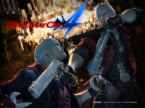
February 5, 2008 - If you want to see how far videogame hardware has come in the past six years or so, try running Devil May Cry 4 alongside the PS2 original. When it came out, back in 2001, the original Devil May Cry was one of the best looking games on the console. Now, in 2008, Devil May Cry 4 is one of the best looking games on both Xbox 360 and PlayStation 3. It's got all the cutting-edge, high definition graphics you'd expect, of course, but just as important is its gratuitous, ridiculous sense of style, full of monocled mad scientists, underground labs, Mephistophelian rivals, bulge-veined creatures, deceptively lesbian snow demons, and assorted femmes fatales.
In this, rather over-the-top, approach Devil May Cry hasn't changed a bit. Another thing that hasn't changed is the underlying design formula. In all its fundamentals, the game is the same as previous Devil May Cry titles: wade through relentless legions of underworld denizens, taking care to dispatch them with SSS-ranking aplomb, and solve puzzles to open up new areas and items. This is no revolutionary reworking, along the lines of Resident Evil 4.
Rather, it's another refinement of Capcom's signature blend of action and exploration – a blend that the company has been evolving across its big-name franchises, Resident Evil, Onimusha, and Devil May Cry. Capcom's DNA is evident throughout the game: in the way the world gradually reveals and discloses its secrets; in the gothic (and sometimes baroque) splendour of its environments; in the grace and poise of its characters; in the jarring segue from moody organ music to high-octane metal that accompanies the game's almost improbable brand of balls-out action.
Indeed, of those three series, Devil May Cry has always offered the most hardcore action, and Devil May Cry 4 is no different: it's a game that's aching for you to smash things up, whether that's the scenery, or one of the inspired selection of evil demons. It's a game that's full of inventive moments, from a snakes and ladders-style dice game, to the various skills that you acquire throughout the game, such as bouncing off special platforms, or entering bullet-time to avoid whirring blades and whizzing lasers. As usual, some of the game's finest moments arrive with the game's bosses, which are universally well designed (Capcom evidently liked them all so much they threw them in again at the end of the game as part of a climactic boss rush – which might not appeal to everyone, but provides some seriously sustained intensity).
character, it won't be spoiling anything for anyone who reads the manual to reveal that you also get to play as Dante at certain points during the game. The two certainly look similar, but Nero doesn't share Dante's laugh-in-the-face-of-danger insouciance, or devil may care attitude. They also each have a very different feel in terms of gameplay: Nero's missions are more exploratory, with a greater emphasis on puzzle-solving; Dante's are mostly all about speed, with several having a time limit of some sort.
You can see it in the rewards they each receive after beating the game's many bosses: Nero receives some new key, or item to unlock new areas; Dante receives some new weapon with which to deal ever more inventive violence. They also handle very differently in combat. Dante's strengths stem from his wide arsenal of weapons (including the utterly insane, transforming, Pandora's Box), giving him a wide range of speedy and direct styles. Nero's strengths are to be found in his demon arm, which he can use to reach enemies from afar, and the new Exceed system.
No comments:
Post a Comment